|
Printables |
PowerPoints |
Online exercises |
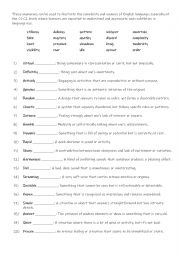
|
Oxymorons
Oxymorons can be used to illustrate the complexity and nuances of English language, especially at C1-C2 level. Answers are on the following page.
Level: advanced
Age: 16-100
Type:
Downloads: 105
|
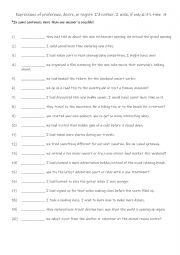
|
A2-B1 Expressions of preference, desire, or regret I�d rather, I wish, if only & it�s time 4
Students should learn expressions of preference, desire, or regret like "I�d rather," "I wish," "If only," and "It�s time" because they help them communicate personal feelings, make choices, and reflect on past experiences or future possibilities in English. These phrases allow students to express what they want, what they regret, or what they feel...
Level: elementary
Age: 10-100
Type:
Downloads: 159
|
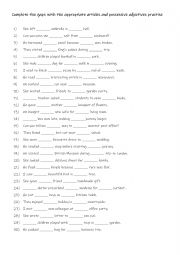
|
Complete the gaps with appropriate articles and possessive adjectives practise
Students read the sentences and decide what article is needed and what possessive adjective will complete the exercise. Answers on page 2.
Level: elementary
Age: 10-100
Type:
Downloads: 123
|
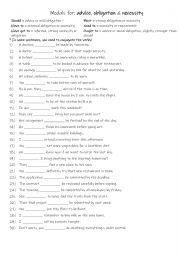
|
A2+-B1+ Modal Verbs for Advice, Obligation, and Necessity
Students familiarise themselves with the 6 modal verbs and their usage. Then they read the sentences to see which modal verb is needed to complete the gap-fill. Answers on page 2.
Level: intermediate
Age: 9-100
Type:
Downloads: 107
|
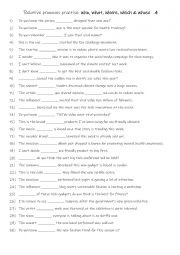
|
A1+-A2 Relative pronouns practise who, what, where, which & whose 4
Mastery of these pronouns also builds grammatical accuracy, making students more confident in formal and informal contexts. First, students need to familiarise themselves with the pronouns and their use. Then they read the sentences to see which one is needed to complete the sentence. Answers on page 2.
Level: elementary
Age: 8-100
Type:
Downloads: 113
|
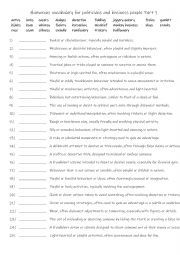
|
Humorous vocabulary for politicians and business people Part 1
Students familiarise themselves with the 25 words and their meanings. Then they read the definitions and write the word being described in the space provided. Answers on page 2.
Level: advanced
Age: 10-100
Type:
Downloads: 124
|
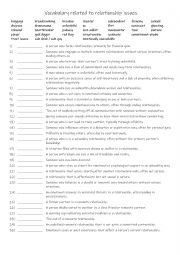
|
B1+-C1 Vocabulary related to relationship issues
Learning vocabulary related to relationship issues enhances communication and awareness of unhealthy patterns, enabling individuals to make informed decisions. Familiarity with terms like "ghosting" and "narcissist" promotes self-reflection, helping people understand their own behaviours and relationship styles. It empowers individuals to set bound...
Level: intermediate
Age: 9-100
Type:
Downloads: 108
|
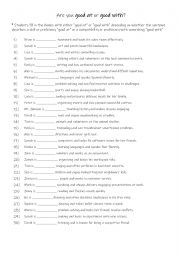
|
A2-B1 Are you good at or good with?
Students fill in the blanks with either good at or good with depending on whether the sentence describes a skill or proficiency good at or a compatibility or proficiency with something good with. Answers on page 2.
Level: intermediate
Age: 10-100
Type:
Downloads: 112
|
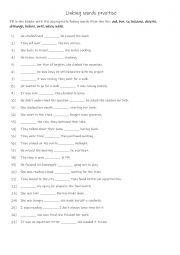
|
A2+-B1+ Linking words practise
Students look at the type of linking words in bold, then read the sentences and complete the gap-fill with one of the following conjunctions:and, but, so, because, despite, although, before, until, when & while. Answers on page 2.
Level: intermediate
Age: 8-100
Type:
Downloads: 115
|
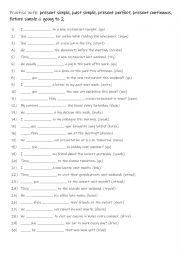
|
A2+-B1 Practise with present simple, past simple, present perfect, present continuous, future simple & going to 2
Practising these tenses allows students to speak confidently about everyday situations, past events, future plans, and hypothetical scenarios. It improves their ability to communicate with precision, enhances fluency, and prepares them for more advanced grammar. Mastery of these structures supports clearer expression of ideas and better understandi...
Level: intermediate
Age: 9-100
Type:
Downloads: 104
|
|
|
|
|












